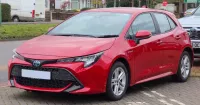1901: Indian Motorcycle Production Begins
In 1901, Indian began motorcycle production.
1902: Norton Motorbike Production
In 1902, British firm Norton began motorbike production.
1903: Triumph Producing Over 500 Bikes
By 1903, Triumph Motorcycles in England was producing over 500 motorbikes.
1907: Douglas Motorcycles Production
In 1907, British firm Douglas Motorcycles began motorbike production.
1910: Birmingham Small Arms Company Motorbike Production
In 1910, British firm Birmingham Small Arms Company began motorbike production.
1915: Introduction of the Model H
In 1915, the Model H was introduced, featuring a 550 cc side-valve four-stroke engine with a three-speed gearbox and belt transmission, and is regarded by many as having been the first "modern motorcycle".
1920: Harley-Davidson as Largest Manufacturer
By 1920, Harley-Davidson had become the largest motorcycle manufacturer, with their motorcycles sold in 67 countries.
April 1924: Chater-Lea Exceeds 100 mph
In April 1924, Chater-Lea became the first 350 cc motorcycle to exceed 100 mph (160 km/h), recording 100.81 mph (162.24 km/h) over the flying kilometer.
1954: NSU Rider Deaths and Abandonment of Racing
After the deaths of four NSU riders during the 1954-1956 seasons, NSU ceased further development and withdrew from Grand Prix motorcycle racing.
1956: NSU Rider Deaths and Abandonment of Racing
After the deaths of four NSU riders during the 1954-1956 seasons, NSU ceased further development and withdrew from Grand Prix motorcycle racing.
1957: Moto Guzzi Racing Success
Until the end of 1957, Moto Guzzi had a succession of victories with its competitive race machines.
1958: Ban of Full Enclosure Fairings
In 1958, due to safety concerns, the FIM banned full enclosure fairings from racing.
1958: Launch of Honda Super Cub
The Honda Super Cub was launched in 1958 and became the biggest selling vehicle of all time.
1975: Catalytic Converters in Cars
Since 1975, catalytic converters have been installed in most gasoline-powered cars and trucks in the United States, but are often absent in motorcycles due to fitment and heat difficulties.
2005: Motorcycle Fatal Crash Rate
United States Department of Transportation data for 2005 shows that motorcycles have a fatal crash rate of 75.19 per 100,000 registered vehicles, four times higher than the rate for passenger cars.
2007: EPA Motorcycle Emissions Certification
According to the United States Environmental Protection Agency 2007 certification reports, the average "Nox+Co End-Of-Useful-Life-Emissions" for motorcycles tested was 0.8531, compared to 0.734 for all vehicles tested, with 54% of tested motorcycles equipped with a catalytic converter.
2007: Motorcycle Fatality Rate per Mile Traveled
Data from 2007 indicates that motorcycle fatalities occur at a rate of 43.47 per 100 million vehicle miles traveled, which is 28 times higher than the rate for passenger cars (37 times more deaths per mile travelled).
April 2008: Honda Super Cub Production Milestone
In April 2008, the 60 millionth unit of the Honda Super Cub was produced, making it the biggest selling vehicle of all time.
2009: Consumer Reports Motorcycle Reliability Survey
A 2013 survey by US Consumer Reports magazine analyzed reliability data from 4,680 new motorcycles purchased between 2009 and 2012, identifying common problem areas like accessories, brakes, and electrical systems, with touring, off-road/dual sport, sport-touring, and cruiser bikes experiencing the most issues.
2010: Compulsory Rider Training
Since 2010, in Ireland, the UK, and some Australian jurisdictions, it is compulsory to complete a basic rider training course before being issued a Learners Licence, after which they can ride on public roads.
2012: Consumer Reports Motorcycle Reliability Survey
A 2013 survey by US Consumer Reports magazine analyzed reliability data from 4,680 new motorcycles purchased between 2009 and 2012, identifying common problem areas like accessories, brakes, and electrical systems, with touring, off-road/dual sport, sport-touring, and cruiser bikes experiencing the most issues.
2013: Consumer Reports Motorcycle Reliability Survey
A 2013 survey by US Consumer Reports magazine analyzed reliability data from 4,680 new motorcycles purchased between 2009 and 2012, identifying common problem areas like accessories, brakes, and electrical systems, with touring, off-road/dual sport, sport-touring, and cruiser bikes experiencing the most issues.
2020: Motorcycle Ban in Lagos, Nigeria
In 2020, motorcycles, popularly referred to as Okada, were banned in Lagos, Nigeria's most populous city, due to safety and security concerns.
2021: Motorcycle sales vs Car sales
In 2021, global motorcycle sales reached approximately 58.6 million units, while car sales totaled 66.7 million units.
2022: Top Motorcycle Producers and Fatality Statistics
In 2022, the top four motorcycle producers were Honda, Yamaha, Kawasaki, and Suzuki. Also in 2022, the US Department of Transportation reported that motorcycle fatalities per vehicle mile traveled were 37 times higher than those for cars.
2024: Proposed Update to Euro 5+ Emission Standards
In 2024, it has been proposed to update European motorcycle emission controls to Euro 5+ standards.
2024: Increased risk of hearing damage
In 2024, motorcyclists and motor scooter riders are exposed to an increased risk of suffering hearing damage such as hearing loss and tinnitus (ringing ears), and medicine is unable to cure hearing damage
Mentioned in this timeline
The United States of America is a federal republic located...
Nigeria is a West African nation the most populous in...

A car also known as an automobile is a wheeled...

The euro is the official currency of the eurozone which...

Sport encompasses physical activities and games frequently competitive and structured...
England a constituent country of the United Kingdom occupies roughly...
Trending

1 month ago Tom Hardy's Spy Thriller overtaken by 'Now You See Me' at Box Office.

5 months ago Naomi Osaka advances in Montreal as Pegula is upset by Sevastova.

5 months ago Robert Downey Jr.'s Cold Brew Debuts Exclusively at Texas Costcos: A Coffee Launch.

7 months ago Stranger Things Season 5: Release Date, Trailer, and Final Episodes Revealed Details

5 months ago Dwyane Wade Defends Legacy Amidst James Harden, Bradley Beal Debate and Clippers Move
John Collins is a professional basketball player currently playing for the Utah Jazz in the NBA He was drafted th...
Popular

Stranger Things created by the Duffer Brothers is a popular...

XXXTentacion born Jahseh Dwayne Ricardo Onfroy was a controversial yet...
Turning Point USA TPUSA is an American nonprofit organization founded...

Candace Owens is an American conservative political commentator and author...

Bernie Sanders is a prominent American politician currently serving as...

Melania Trump a Slovenian-American former model has served as First...